Gene and protein analysis reveals that p53 pathway is functionally inactivated in cytogenetically normal Acute Myeloid Leukemia and Acute Promyelocytic Leukemia
- PMID: 28340577
- PMCID: PMC5423421
- DOI: 10.1186/s12920-017-0249-2
Gene and protein analysis reveals that p53 pathway is functionally inactivated in cytogenetically normal Acute Myeloid Leukemia and Acute Promyelocytic Leukemia
Abstract
Background: Mechanisms that inactivate the p53 pathway in Acute Myeloid Leukemia (AML), other than rare mutations, are still not well understood.
Methods: We performed a bioinformatics study of the p53 pathway function at the gene expression level on our collection of 1153 p53-pathway related genes. Publically available Affymetrix data of 607 de-novo AML patients at diagnosis were analyzed according to the patients cytogenetic, FAB and molecular mutations subtypes. We further investigated the functional status of the p53 pathway in cytogenetically normal AML (CN-AML) and Acute Promyelocytic Leukemia (APL) patients using bioinformatics, Real-Time PCR and immunohistochemistry.
Results: We revealed significant and differential alterations of p53 pathway-related gene expression in most of the AML subtypes. We found that p53 pathway-related gene expression was not correlated with the accepted grouping of AML subtypes such as by cytogenetically-based prognosis, morphological stage or by the type of molecular mutation. Our bioinformatic analysis revealed that p53 is not functional in CN-AML and APL blasts at inducing its most important functional outcomes: cell cycle arrest, apoptosis, DNA repair and oxidative stress defense. We revealed transcriptional downregulation of important p53 acetyltransferases in both CN-AML and APL, accompanied by increased Mdmx protein expression and inadequate Chk2 protein activation.
Conclusions: Our bioinformatic analysis demonstrated that p53 pathway is differentially inactivated in different AML subtypes. Focused gene and protein analysis of p53 pathway in CN-AML and APL patients imply that functional inactivation of p53 protein can be attributed to its impaired acetylation. Our analysis indicates the need in further accurate evaluation of p53 pathway functioning and regulation in distinct subtypes of AML.
Figures
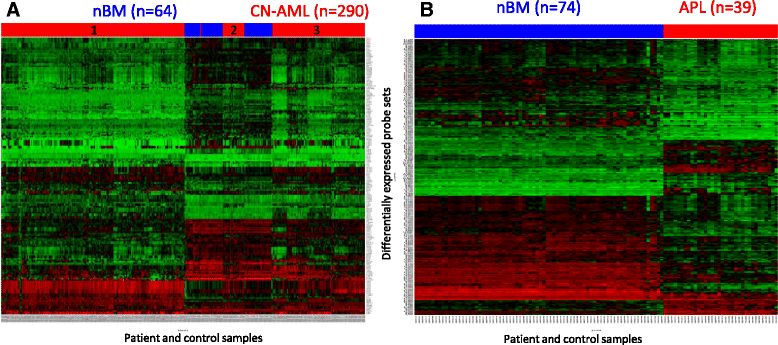
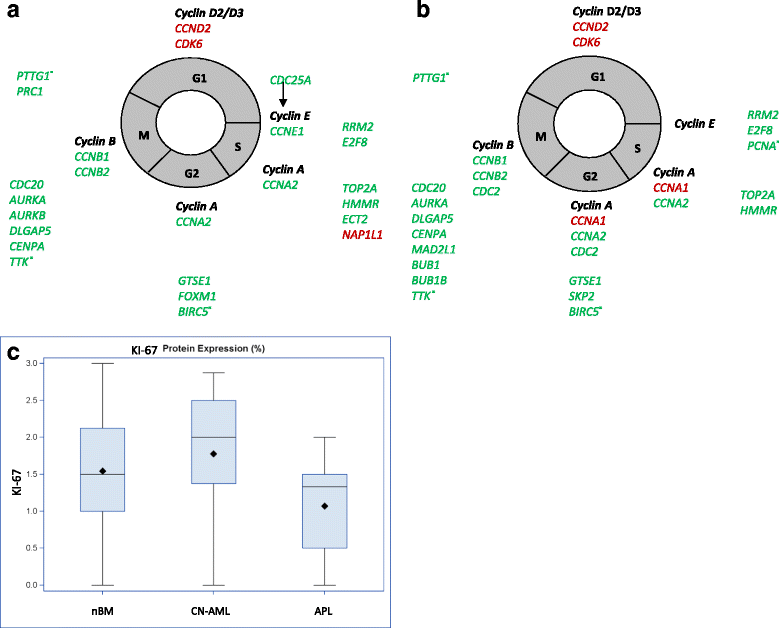
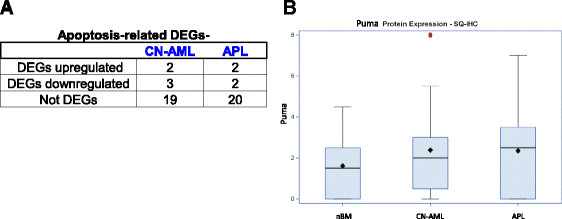
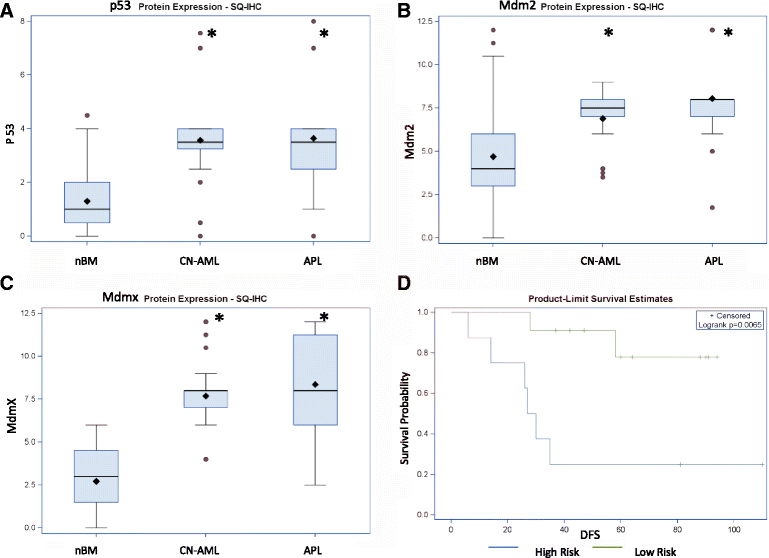
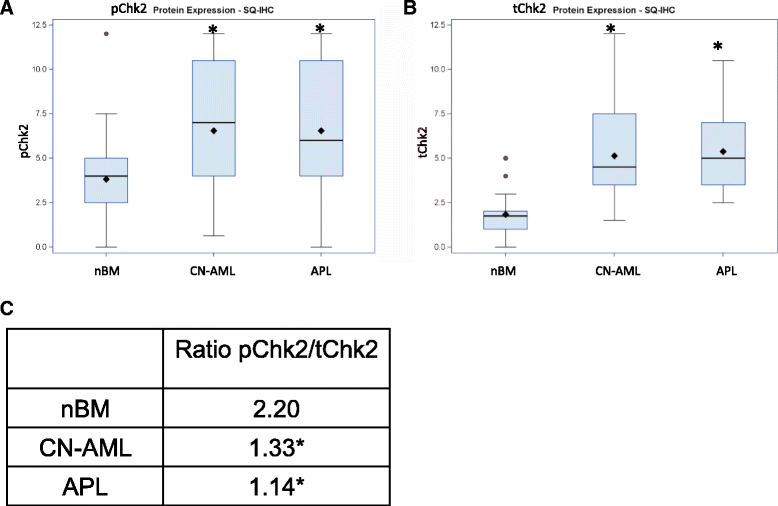
Similar articles
-
Evaluation of growth factor independence 1 expression in patients with de novo acute myeloid leukemia.J Cancer Res Ther. 2020 Jan-Mar;16(1):23-27. doi: 10.4103/jcrt.JCRT_129_17. J Cancer Res Ther. 2020. PMID: 32362605
-
The significance of low PU.1 expression in patients with acute promyelocytic leukemia.J Hematol Oncol. 2012 May 8;5:22. doi: 10.1186/1756-8722-5-22. J Hematol Oncol. 2012. PMID: 22569057 Free PMC article.
-
Identification of signature genes by microarray for acute myeloid leukemia without maturation and acute promyelocytic leukemia with t(15;17)(q22;q12)(PML/RARalpha).Int J Oncol. 2003 Sep;23(3):617-25. Int J Oncol. 2003. PMID: 12888896
-
Gene expression with prognostic implications in cytogenetically normal acute myeloid leukemia.Semin Oncol. 2008 Aug;35(4):356-64. doi: 10.1053/j.seminoncol.2008.04.006. Semin Oncol. 2008. PMID: 18692686 Review.
-
Impact of genomics in the clinical management of patients with cytogenetically normal acute myeloid leukemia.Best Pract Res Clin Haematol. 2015 Jun-Sep;28(2-3):90-7. doi: 10.1016/j.beha.2015.10.005. Epub 2015 Oct 22. Best Pract Res Clin Haematol. 2015. PMID: 26590764 Review.
Cited by
-
Involvement of the PI3K/AKT Intracellular Signaling Pathway in the AntiCancer Activity of Hydroxytyrosol, a Polyphenol from Olea europaea, in Hematological Cells and Implication of HSP60 Levels in Its Anti-Inflammatory Activity.Int J Mol Sci. 2022 Jun 24;23(13):7053. doi: 10.3390/ijms23137053. Int J Mol Sci. 2022. PMID: 35806065 Free PMC article.
-
The Interplay Between the Genetic and Immune Landscapes of AML: Mechanisms and Implications for Risk Stratification and Therapy.Front Oncol. 2019 Nov 7;9:1162. doi: 10.3389/fonc.2019.01162. eCollection 2019. Front Oncol. 2019. PMID: 31781488 Free PMC article. Review.
-
The Pan-Sirtuin Inhibitor MC2494 Regulates Mitochondrial Function in a Leukemia Cell Line.Front Oncol. 2020 May 21;10:820. doi: 10.3389/fonc.2020.00820. eCollection 2020. Front Oncol. 2020. PMID: 32528892 Free PMC article.
-
Epigenetic silencing of ZCCHC10 by the lncRNA SNHG1 promotes progression and venetoclax resistance of acute myeloid leukemia.Int J Oncol. 2023 May;62(5):64. doi: 10.3892/ijo.2023.5512. Epub 2023 Apr 13. Int J Oncol. 2023. PMID: 37052262 Free PMC article.
-
Impact of p53-associated acute myeloid leukemia hallmarks on metabolism and the immune environment.Front Pharmacol. 2024 Aug 5;15:1409210. doi: 10.3389/fphar.2024.1409210. eCollection 2024. Front Pharmacol. 2024. PMID: 39161899 Free PMC article. Review.
References
-
- Acute Myeloid Leukemia. Leukemia and Lymphoma Society. 2015. www.sllcanada.org/sites/default/files/file_assets/PS32_AML_Booklet_FINAL....
-
- Foran JM. New prognostic markers in acute myeloid leukemia: perspective from the clinic. Hematology Am Soc Hematol Educ Program. 2010;2010:47–55. - PubMed
Publication types
MeSH terms
Substances
LinkOut - more resources
Full Text Sources
Other Literature Sources
Medical
Research Materials
Miscellaneous

